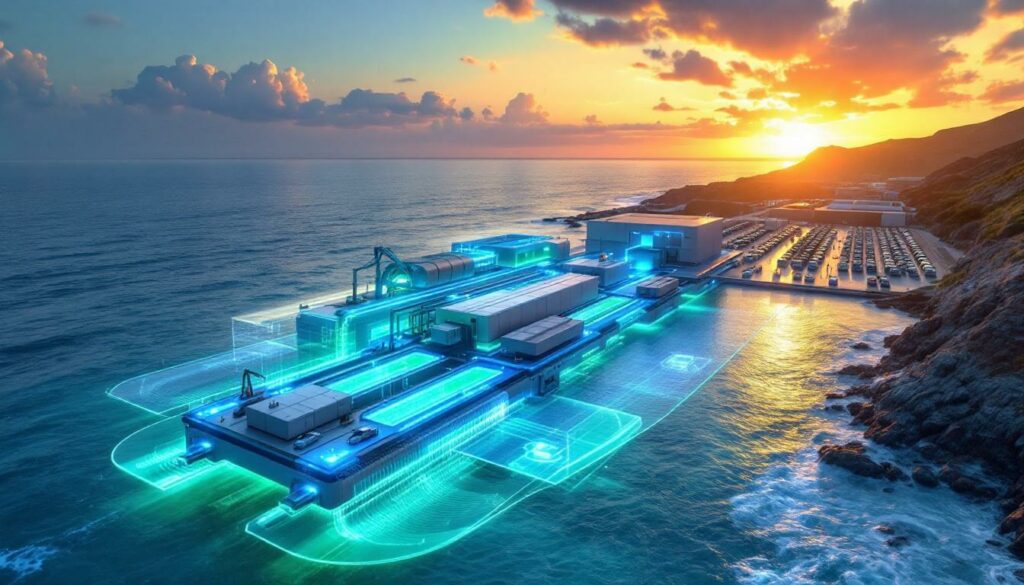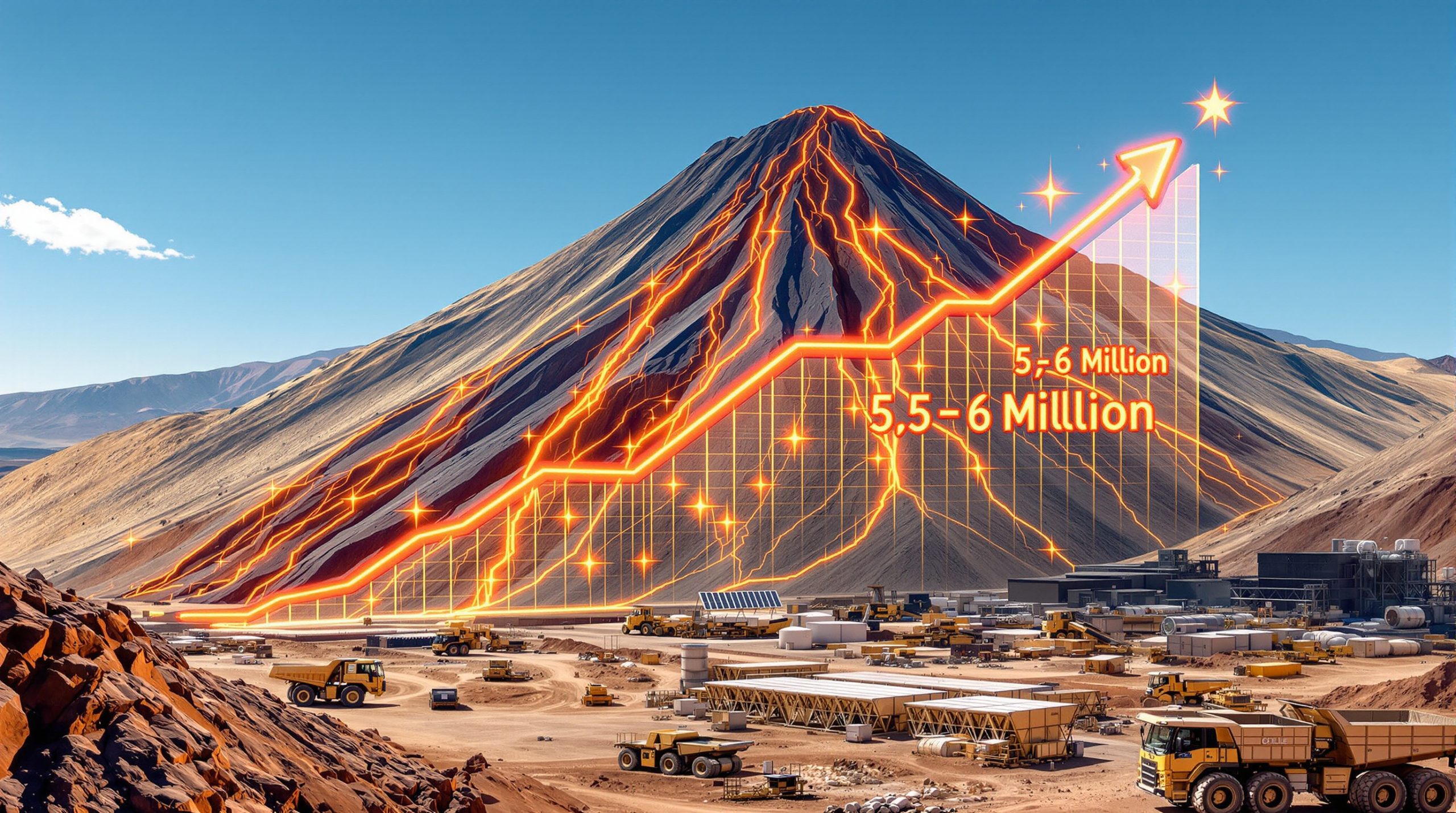The Growing Lithium Demand Challenge
The global transition to clean energy has created unprecedented demand for lithium, a critical mineral essential for batteries powering electric vehicles and renewable energy storage systems. Global lithium demand increased by 63% between 2021 and 2023, jumping from 101,000 tons to 165,000 tons, according to industry data from Oilprice.com.
Industry projections indicate this demand will surge by an additional 222% to reach 531,000 tons by 2030, creating significant supply chain pressures. This exponential growth is primarily driven by electric vehicle manufacturing and grid-scale energy storage systems that are essential for integrating renewable energy sources.
The electrification revolution is so pronounced that even traditional oil markets are feeling the impact. China, traditionally one of the world's largest oil consumers, has seen its oil demand growth slow substantially due to the rapid adoption of electric vehicles, further validating the lithium-driven transformation of the transportation sector.
Supply-Demand Imbalance
As battery technology advances and costs decrease, the gap between lithium supply and demand continues to widen. Without significant new sources, many analysts predict a supply deficit could emerge as early as 2027, potentially stalling the clean energy transition at a critical juncture.
"The lithium supply crisis isn't just about having enough batteries—it's about whether the clean energy transition can maintain its momentum," notes industry analysts tracking critical mineral markets.
Why Traditional Lithium Mining Falls Short
Environmental Impacts of Conventional Extraction
Traditional lithium mining methods come with substantial environmental costs. Current extraction techniques typically involve either open-pit mining of lithium-rich rock or evaporating lithium-rich brine in vast evaporation ponds. Both methods create significant ecological disruption:
- Water intensity: Brine extraction in regions like South America's Atacama Desert consumes enormous quantities of freshwater—often exceeding 500,000 liters per ton of lithium—in already water-stressed regions
- Habitat destruction: Open-pit mining destroys local ecosystems and creates lasting landscape alterations
- Chemical pollution: Processing operations generate chemical waste and potential contamination risks
- Arid region vulnerability: 50% of lithium mines are located in very high and arid areas, compounding water scarcity issues
The environmental footprint of traditional lithium extraction stands in stark contrast to the environmental benefits of the technologies it powers, creating an uncomfortable paradox for the clean energy industry.
Geopolitical Vulnerabilities in the Supply Chain
The current lithium supply chain presents serious geopolitical concerns:
- 85% of global lithium production is concentrated in just three countries: Australia, Chile, and China
- Chinese companies control approximately 25% of global lithium mining capacity
- China dominates 60% of the world's refining capacity for battery-grade lithium
- By 2026, China is projected to overtake Australia as the world's largest lithium producer
This concentration creates significant supply vulnerabilities, especially as countries increasingly view critical minerals energy security through a national security lens. The 2022-2023 supply chain disruptions highlighted the risks of relying on geographically concentrated resources, prompting many nations to classify lithium as a strategic resource.
Price Volatility Challenges
Despite growing demand, lithium markets have experienced paradoxical price volatility. Prices dropped by approximately 70% in 2023 due to Chinese overproduction, according to Reuters reporting, creating investment uncertainty that has slowed the development of new production capacity outside China.
The Seawater Solution: Mining Without a Mine
Breakthrough Vermiculite Membrane Technology
Researchers from the U.S. Department of Energy's Argonne National Laboratory and the University of Chicago have developed an innovative lithium extraction approach that could transform the industry. Their method uses a specialized membrane made from vermiculite, an abundant and naturally occurring clay material.
Unlike previous attempts at extracting lithium from seawater, this new technology:
- Filters lithium ions with remarkable efficiency by targeting both ion size and charge
- Operates without the massive water consumption required by traditional methods
- Uses abundant, cost-effective materials that can be deployed at scale
- Avoids the environmental degradation associated with conventional mining
"Filtering by both ion size and charge, our membrane can pull lithium out of water with much greater efficiency," explains Yining Liu, a PhD candidate at the University of Chicago and first author of the study published in Advanced Materials (DOI: 10.1002/adma.202417994).
How the Technology Works
The vermiculite membrane functions as a highly selective filter that can separate lithium ions from the numerous other elements present in seawater. This selectivity is crucial, as seawater contains lithium in extremely dilute concentrations (typically 0.1-0.2 parts per million).
The membrane works through a dual-filtering mechanism:
- Size exclusion – physically blocking larger ions while allowing smaller lithium ions to pass
- Charge selectivity – attracting positively charged lithium ions while repelling other similarly charged particles
This dual-filtering approach achieves significantly higher efficiency than previous extraction attempts, with laboratory tests showing greater than 90% efficiency in lithium capture. This breakthrough makes seawater lithium extraction economically viable for the first time.
The Virtually Unlimited Resource
While lithium concentrations in seawater are low, the sheer volume of the world's oceans creates an essentially unlimited resource. Seawater contains an estimated 230 billion tons of lithium—more than 10,000 times the currently identified land-based reserves of 22 million tons.
This abundance means that even with exponential growth in lithium demand, seawater could theoretically supply global needs for centuries.
What Makes Seawater Extraction Revolutionary?
Democratizing Lithium Production
The most transformative aspect of seawater lithium extraction is its potential to completely restructure global supply chains:
- Any nation with coastal access could potentially become a lithium producer
- Reduces dependency on geographically concentrated mining operations
- Decreases vulnerability to supply disruptions from political instability or trade conflicts
- Creates opportunities for more equitable distribution of economic benefits
"Such a membrane could reduce our dependence on foreign suppliers and open new lithium reserves," Liu notes, highlighting the geopolitical significance of this technology. With more than 150 nations having coastal access, the potential for widespread production could fundamentally alter global mineral politics.
Environmental Advantages
Seawater extraction offers significant environmental benefits compared to traditional mining:
- Land preservation: Eliminates land disturbance from open-pit mining
- Freshwater conservation: Reduces freshwater consumption in arid regions
- Reduced contamination: Minimizes chemical waste and contamination risks
- Sustainable sourcing: Provides a virtually unlimited resource that doesn't deplete local ecosystems
By eliminating the environmental contradictions inherent in traditional lithium mining, seawater extraction better aligns the clean energy supply chain with its environmental objectives.
Climate Resilience Benefits
Beyond the direct environmental advantages, seawater lithium extraction offers enhanced climate resilience:
- Less vulnerable to drought conditions that affect brine operations
- Reduced dependency on increasingly water-stressed regions
- More distributed production capacity reduces climate-related supply chain risks
Beyond Lithium: Broader Applications
Extracting Other Critical Minerals
The membrane technology has potential applications beyond lithium extraction. Researchers believe similar approaches could be developed to extract other critical minerals from seawater, including:
- Nickel and cobalt (essential for battery cathodes), present in seawater at concentrations of 0.0005-0.002 ppm and 0.0001-0.005 ppm respectively
- Rare earth elements (used in magnets for electric motors)
- Other strategically important metals currently facing supply constraints
The selective ion filtration principles behind the vermiculite membrane can potentially be customized to target specific elements by adjusting the pore size and charge characteristics.
Water Purification Applications
The same technology that extracts valuable minerals could potentially be adapted to remove harmful contaminants from drinking water supplies:
- Filtering heavy metals from contaminated water sources
- Removing industrial pollutants from wastewater
- Ironically, addressing water contamination issues created by traditional mining operations
Laboratory trials have already demonstrated the membrane's effectiveness in removing toxic elements like lead and mercury from water samples, suggesting dual applications for both resource extraction and environmental remediation.
Challenges to Commercialization
Scaling the Technology
While promising in laboratory settings, several challenges must be addressed before seawater lithium extraction can be deployed at commercial scale:
- Membrane production: Developing large-scale membrane production facilities capable of producing thousands of square meters of filtering material
- Throughput engineering: Engineering efficient systems to process massive volumes of seawater—likely billions of liters daily for commercial operations
- Infrastructure development: Creating infrastructure to handle the extraction and processing operations, particularly in coastal areas
- Energy optimization: Optimizing energy consumption for economic viability, as pumping and processing seawater requires significant power
The transition from laboratory success to industrial application represents a significant hurdle for any new technology, and seawater lithium extraction is no exception.
Economic Considerations
The economics of seawater lithium extraction will ultimately determine its viability:
- Capital expenditure: Initial capital costs for facility construction, estimated to be substantial but potentially competitive with new mine development
- Energy requirements: Operational energy requirements compared to traditional mining, with desalination plants providing a useful benchmark (3-10 kWh/m³)
- Processing costs: Costs to convert extracted lithium into battery-grade materials
- Market competitiveness: Overall economic competitiveness against established lithium sources, particularly in a market with volatile pricing
While full cost projections are still being developed, researchers believe that with optimization and economies of scale, seawater extraction could become cost-competitive with traditional mining, especially as environmental regulations tighten.
Market Implications for the Lithium Industry
Potential Price Stabilization
The lithium market has experienced significant price volatility, with paradoxical slumps despite growing demand, largely due to overproduction from China. Seawater extraction could help stabilize prices by:
- Diversifying supply sources beyond current geographic concentrations
- Reducing dependency on producers who might manipulate markets
- Creating more predictable production capacity that can scale with demand
- Establishing a price floor based on extraction costs rather than geopolitical factors
More stable lithium prices would benefit the entire clean energy ecosystem, from battery manufacturers to electric vehicle producers, enabling more reliable long-term planning.
Impact on Traditional Producers
If seawater extraction becomes commercially viable, traditional lithium producers would face significant competitive pressure:
- High-cost producers might struggle to remain profitable
- Companies would need to improve environmental performance to compete
- Producers with the most environmentally damaging practices could face obsolescence
- The value of lithium deposits in traditional mining regions could potentially decrease
Australian miners, who often have higher production costs than South American lithium brine opportunities, might be particularly vulnerable to competition from seawater extraction. This could potentially impact Australian mining stocks if the technology advances rapidly.
Reshaping Investment Strategies
The emergence of seawater lithium extraction technology is already influencing investment strategies in the critical minerals sector:
- Increased interest in companies developing advanced extraction technologies
- Growing caution around traditional mining projects with high capital costs and long development timelines
- Enhanced scrutiny of environmental practices among existing producers
- Strategic repositioning by mining companies to diversify their extraction methods
"The investment calculus changes significantly when a virtually unlimited resource becomes technically accessible," notes industry analysts. "Long-term lithium prices may eventually be determined more by processing technology than by resource scarcity."
The Timeline to Implementation
Current Research Status
The vermiculite membrane technology remains in the research and development phase:
- Laboratory testing has demonstrated proof of concept
- Efficiency metrics show promising results compared to previous attempts
- Researchers are working to optimize the membrane composition and structure
- Small-scale pilot projects will likely be the next development stage
Membrane durability testing is ongoing, as commercial applications would require materials that can withstand continuous operation in corrosive seawater environments.
Projected Commercialization Path
Based on typical technology development timelines, seawater lithium extraction might follow this path:
- Continued laboratory optimization (1-2 years)
- Small-scale pilot projects (2-3 years)
- Demonstration plants (3-5 years)
- First commercial facilities (5-7 years)
- Widespread adoption (7-10+ years)
This timeline suggests that seawater lithium could begin making meaningful contributions to global supply around 2030-2032, coinciding with the projected peak demand period for lithium as electric vehicle adoption accelerates worldwide.
Historical Parallels
The adoption curve for seawater lithium extraction may resemble that of desalination technology, which took approximately 10-15 years to move from breakthrough membrane technology to widespread commercial implementation. However, the strategic importance of lithium could accelerate investment and development.
How Would This Affect the Green Energy Transition?
Securing Battery Supply Chains
A more diverse and resilient lithium supply would significantly benefit the green energy transition:
- Electric vehicle manufacturers could plan production with greater confidence
- Energy storage deployment could accelerate without supply constraints
- Price stability would improve cost predictability for clean technology products
- Reduced geopolitical risks would encourage investment in battery-dependent technologies
With electric vehicles requiring approximately 60kg of lithium per vehicle, a stable supply chain is essential for achieving ambitious production targets. Companies like Tesla, with 2030 battery production targets of 20 TWh, would benefit substantially from diversified lithium sources.
Addressing Environmental Criticisms
The clean energy transition has faced legitimate criticism regarding the environmental impacts of mining required materials. Seawater lithium extraction could help address these concerns by:
- Reducing the ecological footprint of battery production
- Aligning the means of production with the environmental goals of clean energy
- Improving public perception of battery technologies as truly sustainable
- Creating a more holistic approach to environmental stewardship in the energy transition
"Seawater extraction aligns the means of production with clean energy's environmental goals," notes the Oilprice.com analysis, highlighting how this technology could resolve one of the most persistent contradictions in the clean energy narrative.
Accelerating Decarbonization
By removing a potential bottleneck in the clean energy supply chain, seawater lithium extraction could accelerate global decarbonization efforts:
- Faster electric vehicle adoption through secured battery supply
- More rapid deployment of grid-scale energy storage
- Reduced carbon emissions from the lithium supply chain itself
- Enhanced confidence in meeting national and international climate targets
FAQs About Seawater Lithium Extraction
Is there enough lithium in seawater to meet global demand?
Yes, seawater contains an estimated 230 billion tons of lithium—far more than land-based reserves of 22 million tons and enough to meet projected demand for centuries, even with exponential growth in battery usage.
How energy-intensive is the extraction process?
While specific energy requirements for commercial-scale operations are still being determined, researchers are focusing on optimizing energy efficiency. The process will require energy input, but likely less than the combined energy costs of traditional mining, processing, and transportation from remote locations. Desalination plants, which use similar membrane technologies, typically consume 3-10 kWh per cubic meter of water processed.
Could this technology completely replace traditional lithium mining?
In the long term, seawater extraction could potentially replace most traditional lithium mining, especially as the technology matures and economies of scale develop. However, a transition period would likely include both sources operating simultaneously, with traditional mining gradually decreasing in market share as seawater extraction scales up.
What are the potential environmental impacts of large-scale seawater processing?
The primary environmental considerations include energy usage, the disposal of processed seawater, and the construction of coastal facilities. However, these impacts are expected to be significantly less severe than those associated with traditional mining operations. Proper facility design can minimize marine ecosystem disruption, and renewable energy can power extraction operations.
When might commercial production begin?
Based on current research progress and typical technology development timelines, the first commercial-scale seawater lithium extraction facilities could be operational within 5-7 years, with widespread adoption following in the 7-10+ year timeframe.
How Seawater Could Solve the Lithium Supply Crisis
The development of efficient lithium extraction from seawater represents a potential paradigm shift in how we source critical minerals for the clean energy transition. By tapping into the vast reserves dissolved in the world's oceans, we could address multiple challenges simultaneously: meeting growing demand, reducing environmental impacts, and creating more equitable and resilient supply chains.
While significant technical and economic hurdles remain before commercial implementation, the promise of "mining without a mine" offers a compelling vision for a more sustainable approach to resource extraction. As research continues and pilot projects develop, seawater lithium extraction could emerge as a key enabler of the global transition to clean energy technologies.
The vermiculite membrane technology developed by researchers at Argonne National Laboratory and the University of Chicago stands as a powerful example of how innovative lithium technologies can potentially resolve seemingly intractable resource challenges. By fundamentally rethinking extraction methods, we may discover that some of our most pressing supply constraints aren't limitations of geology, but rather limitations of technology and imagination.
As this technology matures, it could transform lithium
Want to Capitalise on the Next Lithium Breakthrough?
Stay ahead of the market with real-time alerts on significant ASX mineral discoveries through Discovery Alert's proprietary Discovery IQ model, turning complex lithium exploration data into actionable investment insights. Explore how major mineral discoveries can generate substantial returns by visiting the Discovery Alert discoveries page and position yourself to benefit from the next lithium breakthrough.




